|
The
first class players of the City of London Chess Club in their match
against the fourth class. Upper row (from left to right): George A.
MacDonnell, George Adamson, Bernard Horwitz and William R. Ballard.
Second row: Ladislas Maczuski, James Mason and William N. Potter. Third
row: Frank Healey, Philipp Hirschfeld, Joseph H. Blackburne, J.J.
Scargill and Edward Ridpath. The identities of the lookers-on are
unknown.
.
The City Club's First Class
Had a Busy 1881
.
The first class players of the
City of London Chess Club had a busy 1881. The London club organized
that year two special matches in which they made an appearance.
Generally, the City club had two sort of
meetings in which the top-players gave evidence of their chess skills.
The crème de la crème
of the club played in the club's handicap tournament and gave monthly
simultaneous exhibitions. The usual performers at the latter gatherings
were Joseph H. Blackburne, George A. MacDonnell, James Mason and William
N. Potter.
1881, however, was a more lively year. The
first of the two extraordinary meetings was an affair on a large scale:
a match against the other prominent London society, the St. George's
Chess Club. The second gathering, a match between first class players of
the City of London Chess Club and their fourth class opponents, was a
small matter in comparison with the first competition, but, nonetheless,
still a happening of great interest, if we may believe several
contemporary sources.1
The picture above is of the match between the
first and fourth class players of the City of London Chess Club, which
took place on December 12, 1881. The original plan was to pair ten
contestants of each side, but the actual match was between nine players.2
The first class players were, in alphabetic
order, William R. Ballard, Blackburne, Frank Healey, Philipp Hirschfeld,
Bernard Horwitz, MacDonnell, Ladislas Maczuski, Mason and Potter. When
papers announced the match Isidor Gunsberg and Samuel S. Boden were also
mentioned as possible participants, but they did not take part.3
If we may believe The Chess
Player's Chronicle (December 13, 1881), the first class team was
the strongest that had been brought together in many years.
The fourth class of the City of London Chess
Club was represented, again in alphabetic order, by F. Atkinson, M.D.
Blunt, J. Foster, E. George, J.B. Hunnex, Edward Ridpath, J.J. Scargill,
H.S. Staniforth and Edward Wells. Two other members were expected to
play, Benjamin G. Laws and L. Stiebel, but for mysterious reasons they
did not participate.4 MacDonnell wrote in The
Illustrated Sporting and Dramatic News (December 17, 1881) that the
principal members of the fourth class were conspicuous by their absence.
The captain of the first class was Blackburne.
Stiebel was announced the leader of the other side. 5 His
substitute is unknown. Because of the considerable diversity of strength
in each class, the players on each side were divided in two sections,
the first consisting of five and the second of four players. The
contestants in each section were then paired by lot.6
Presumably Blackburne, MacDonnell, Mason and Potter (and their opponents)
belonged to the first section.
The match, which attracted a crowd of
spectators, was held in Mouflet's Hotel, 24 Newgate street (the club's
domicile), and commenced
at 6.00 p.m.7
The first class players gave the odds of a knight. The match seems to
have been a one-sided affair, the first class winning 8½ to ½. It was,
however, not always that easy.8
As usually happens in such cases, several pieces of luck fell to the lot
of the stronger party. Mr. Healey's opponent missed an easy win from
failing to see an obvious move, and Dr. Ballard's threw away a winning
game from over-confidence. Thinking he could force a mate he sacrificed
a Rook, but the expected mate did not come off, and he was left with a
losing game. Mr. MacDonnell's opponent played very stiffly, and for a
long time retained the advantage of the piece, while, though a Pawn
short, he had a "Pastor" which threatened to give some trouble to
his clerical opponent. At the close, however, MacDonnell won in
brilliant style. The game between Messrs. Potter and Hunnex, which was
the last to be finished, had a most singular termination. The second
player threatened a seemingly formidable attack, which almost compelled
the sacrifice of the Queen; while, on the other hand, this sacrifice was
not only the best move, but immediately forced the game. Mr. Potter
threatened either to Queen a Pawn or checkmate with Knight and Rook. His
opponent might have prevented either, but not both.
MacDonnell gave his opinion why the fourth class players were so
thoroughly beaten by the first class:9
They did not play their usual
game, the style of game they would have adopted against an equal player;
they were frightened. They saw ghosts where no ghosts were. They
magnified their opponents into giants and fancied themselves to be but
dwarfs. In short, they did not play up to their real strength. Thus one
man would not castle in an even game; another played to effect an
exchange of queens to silence, as it were, the big guns of the adversary,
and, in endeavouring to accomplish his object, weakened his own position
and exposed his king and other pieces to the musketry that was rattled
upon them with deadly effect from the smaller pieces. Others played to
exchange off all pieces in the hope of getting an end game wherein their
extra knight would prove the master of the situation, whereas there is
no part of the game in which the skill of the superior player is so
likely to tell as in what are called pawn end-games. In them a pawn
properly handled is often stronger than a piece. Then judgment (based
upon long experience) rather than ingenuity is the essential to victory.
It was by acting upon these and similar false principles that the junior
players were in most cases defeated.
The following is the score list:
|
Ballard – Foster
|
1-0
|
|
MacDonnell – Staniforth
|
1-0
|
|
Blackburne – Ridpath
|
1-0
|
|
Maczuski – Atkinson
|
1-0
|
|
Healey – George
|
½-½
|
|
Mason – Wells
|
1-0
|
|
Hirschfeld – Scargill
|
1-0
|
|
Potter – Hunnex
|
1-0
|
|
Horwitz – Blunt
|
1-0
|
|
Total
|
8½-½
|
Three
games of this contest have survived.
Bernhard
Horwitz
- M.D.
Blunt
-
City
of London Chess Club, Match First Class vs. Fourth Class
-
London,
December 12, 1881
-
Odds
of King's Knight
1.
e4 e5 2. Bc4 Bc5 3. 0–0 Nf6 4. b4 Bxb4 5. c3 Bc5 6. d4 exd4 7. cxd4 d5
As
White has castled and is prepared to advance the king's bishop's pawn,
Black would have obtained a safer game by retreating the bishop to b6.
8.
exd5 Be7 9. Nc3 0–0 10. f4 Nbd7
10.
c6 would have been better.
11.
Bb3 Nb6
It
was hardly worth while posting his knight badly for the sake of this
attack on the pawn.
12.
Qf3 c6
Probably
his best course here was 12. ... Bg4 and 12. ... Bf5.
13.
dxc6 Qxd4+ 14. Kh1 bxc6 15. Bb2
White
displays all his old-time ingenuity and judgment in the management of
the opening.
15.
... Qd8
15.
... Qc5, followed by Bg4, seems a preferable line of play.
16.
Rad1 Qc7 17. h3 Be6 18. Rc1 Bxb3 19. axb3 a6 20. Ne2 Nbd5 21. Nd4 c5 22.
Nf5
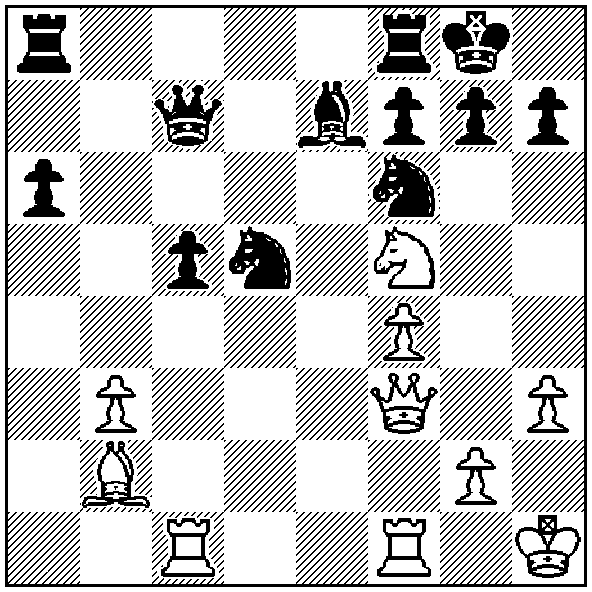
22.
... g6
He
had no really good move, as White threatened to capture the king's
knight's pawn at once, but this exposure of the king to the action of
the adverse bishop was injudicious.
23.
Qxd5
Here
the master's hand is seen.
23.
... gxf5 24. Qxf5 Qc6 25. Rfe1 Nd5 26. Rcd1 Rad8 27. Rd3 Nxf4
A
clever retort.
28.
Rg3+ Ng6 29. Rxe7 Rd5 30. Qf4 Rh5 31. Kh2 h6 32. Rc7 Qe6 33. Qf3
The
manoeuver by which White induces the queen to abandon the protection of
the knight is very amusing.
33.
... Qd5 34. Rxg6+,
and
Black resigned.
Source:
The
Illustrated London News,
April 1, 1882 (notes by Patrick T. Duffy).
William
N. Potter
- J.B.
Hunnex
-
City
of London Chess Club, Match First Class vs. Fourth Class
-
London,
December 12, 1881
-
Odds
of Queen's Knight
1.
d4 d5 2. e3 Nf6 3. Bd3 c5 4. c3 Nc6 5. f4
Fearing
pawn to e5, which would yield Black a too rapid development.
5.
... e6
Good
in its way, though he could well afford Ne4 at these odds.
6.
Nd2 Qb6 7. Qf3
Castling
would be bad on account of cxd4, followed by knight takes pawn.
7.
... Be7 8. h3 h5 9. b3 cxd4 10. exd4 Bd7 11. Bb2 Nh7
Black
having opened his game well has a good position, but here goes astray.
He should play pawn to h4, intending Nh5.
12.
Qxh5 0–0–0 13. 0–0–0 g6 14. Qf3 Kb8 15. Kb1 Rc8 16. Qe3 Bf6 17.
Rhe1 Rhe8 18. Nf3 Rc7 19. g4 Nf8 20. Qd2 Rec8 21. Rc1 Na5 22. h4 Bb5 23.
Bc2 Bc4
Highly
ingenious, and bringing on a position of much danger for White.
24.
h5
Anxious
to make the most of his extra pawn in view of coming perils, but b4 is
probably preferable, so as to prevent the intended sacrifice.
24.
... Be7 25. Ne5
Pawn
to b4 would seem still the safest course.
25.
... Bxb3 26. Bxb3 Nxb3 27. axb3 Qxb3 28. Nxf7
The
policy of this capture would be highly doubtful but for his being a pawn
behind in an inferior position.
28.
... Nd7
A
far-seeing continuation.
29.
hxg6
If
29. Re3 Nb6 30. c4 Nxc4, winning.
29.
... Nb6 30. Qc2 Qb5 31. Ne5 Na4
A
long threatened, and decidedly formidable, though there is also much to
be said for Rxc3.
32.
Ka1 Qa5 33. Kb1
Practically
offering a draw.
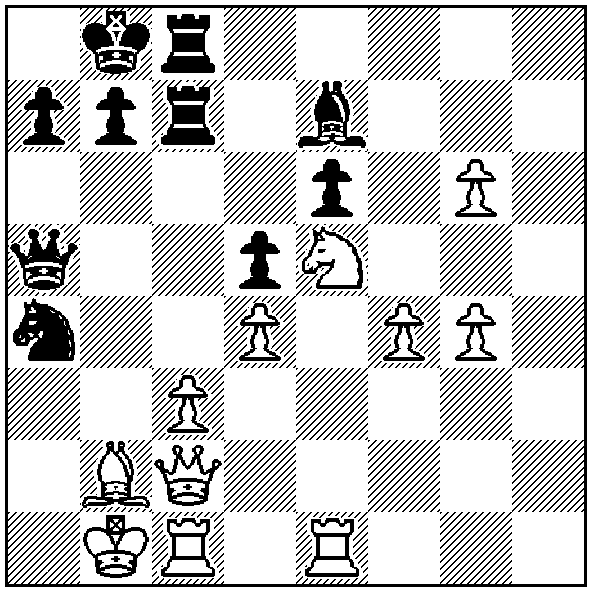
33.
... Rxc3
Seemingly
a crushing move, but not really so. As to the alternatives neither 33.
... Nxb2 nor 33. ... Nxc3 would amount to much. There is, however, more
point about 33. ... Ba3, a move involving much interesting play, but we
do not find that Black thereby force the game. Numerous variations could
be adduced at this and other stages, but we have not space for them.
This indeed is our usual condition, but we are at all times willing to
supply our readers with such explanations as they may require for the
clearing-up of difficulties.
34.
Qb3
Sufficient
to save, and also yielding various winning possibilities.
34.
... Nxb2
Which
enables White to force a not very obvious victory. Black might with less
ill-effect play 34. ... Bd6 or 34. ... Rxc1+. It may be thought that 34.
... a6 is much stronger than either, but as a matter of fact, that move
would yield White a comfortable advantage. Black's best course is 34.
... b6.
35.
Rxc3 Rxc3 36. Qxc3
Resigns.
If 36. ... Qxc3 37. Rc1 Na4 38. Rxc3 Nxc3+ 39. Kc2
Ne4 40. g7 Nf6 41. Nd7+ winning easily.
Sources:
Land
and Water,
December 17, 1881 (notes by William N. Potter), The
Chess Player's Chronicle, December 27, 1881.
Philipp
Hirschfeld
- J.J.
Scargill
-
City
of London Chess Club, Match First Class vs. Fourth Class
-
London,
December 12, 1881
-
Odds
of Queen's Knight
1.
e4 e5 2. Nf3 Nc6 3. Bc4 Bc5
The
Hungarian Defense, viz. 3. ... Be7, would be good at the odds. If then
4. c3 Nf6 5. d4 d6, and the odds receiver's nerves will scarcely be
agitated by early complications.
4.
b4 Bb6 5. 0–0 d6 6. a4 a6 7. a5 Ba7 8. c3 Nf6 9. d3 Ne7 10. Bb3 Ng6
11. h3 0–0 12. Bg5 h6 13. Bd2 Bd7
Mr.
Scargill having conducted the opening skillfully has a good game, but he
now shows signs of failing into a common error of knight's receivers,
viz., going on as if playing on even terms. Here either 13. ... d5 or
13. ... Be6 14. Bc2 d5 would be promising.
14.
Kh2 Kh7 15. Qe2 Qe7 16. Rg1
Aiming
at an attack not difficult to fall, but in odds games more profit often
ensues from a foiled attack than from one allowed its run, this being on
account of the weaknesses thereby introduced.
16.
... Nf4
Nh4
is preferable; not however that White would take the knight.
17.
Bxf4 exf4 18. g4 g5 19. d4
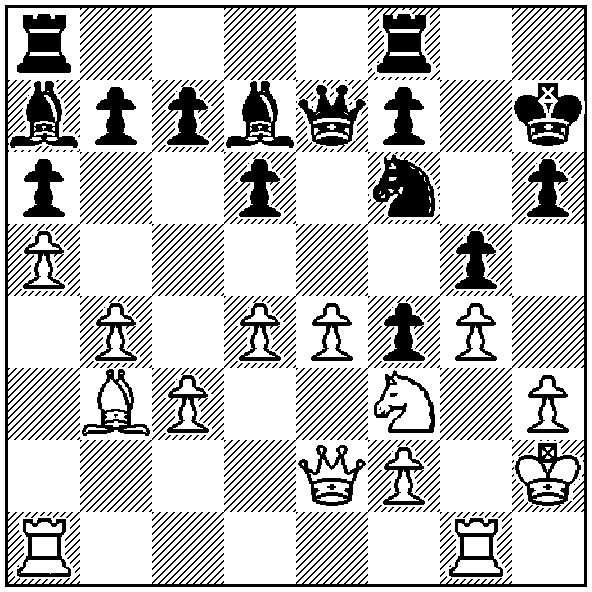
19.
... d5
The
position is too difficult between unequal strengths. His best source is
some waiting move, not absolutely purposeless, such as Rae8. The text
move is far from being well considered.
20.
e5 Ne4
Which
loses a piece. He should play either c6 or Ng8, the latter for choice.
21.
Bxd5 f5
21.
... Nxc3 22. Qc2+ Kh8 23. Qxc3 c6 gives the best chance of a struggle.
The game may be left here, as Mr. Hirschfeld's victory is a foregone
conclusion.
22.
exf6 Rxf6 23. Qxe4+ Qxe4 24. Bxe4+ Kg7 25. Bxb7 Rd8 26. Rge1 Kf8 27. Re5
Bb8 28. Rd5 Rd6 29. Rxd6 cxd6 30. Bxa6 Bc6 31. Nd2 Re8 32. Bd3 f3 33. b5
Ba8 34. b6 Re7 35. a6
Resigns.
Sources:
Land
and Water,
January 7, 1882 (notes by William N. Potter), The
Chess Player's Chronicle, December 27, 1881.
The
other
match, against the rivaling society, the West End club, arose out of a
challenge by third class players of the City of London Club to the St.
George's Chess Club. Whether this challenge was only meant for third
class players of the St. George's or the whole club, is not clear.10
Whatsoever,
the two secretaries of the clubs – George Adamson of the City and
James I. Minchin of St. George's – seized the opportunity with both
hands to organize a full strength match, even though the relation
between the two clubs had been far from good in the past.11
The relationship was dominated by sore feelings, and, therefore, it was
somewhat surprising to the chess public that an attempt was made to
accomplish this contest.
Land
and Water
(February 26, 1881) was the first paper to mention the possibility of
the match. Like other British chess editors, William N. Potter was
convinced of the significance of the match.12
The
news will be received with eager interest amongst chessists in every
part of the globe. There can be no doubt that these two clubs are the
strongest chess societies in the world. Few will take issue with this
statement, and in any case no one will deny that they comprise amongst
their leaders the majority of the foremost chess champions of the day.
The conditions of the match were far from clear at the moment Land
and Water published the announcement. It was generally understood
that twenty players would be engaged on each side, but nothing was known
about time and place.13
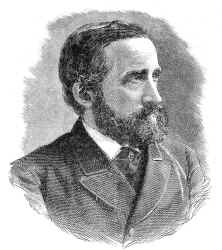  Johannes
H. Zukertort, Wilhelm Steinitz Johannes
H. Zukertort, Wilhelm Steinitz
Land and Water was the first
paper to shed light on this matter. The paper of March 5, 1881, reported
that the encounter would take place on Thursday, March 24, 1881, at the
rooms of the St. George's Chess Club, 20 King street, St. James's.
Play to commence at 6.00 p.m.
and to conclude at 12.00 p.m.
Time limit: twenty moves per hour. Each club would be represented by
fifteen players, playing two games if time permitted (the second game
not being commenced after 9.30 p.m.,
did The Chess Player's Chronicle
of March 8, 1881, add). Unfinished games to be adjudged by the captains
of the teams, Joseph H. Blackburne and Johannes H. Zukertort, and Samuel
S. Boden, who was an honorary member of both clubs, acting as umpire.
The
conditions of the match, as well as the way in which it was arranged,
met resistance. The limitation to fifteen players was one of the rules
raising questions. It was
evident that this adjustment was a concession by the City of London
Chess Club to the St. George's.14 The City club had far
more third class players than the opponent: diminishing the number of
contestants was to the advantage of the St. George's. The City
of London Chess Club, in its 29th year in 1881, numbered about 150
members15; the membership of the St. George's club was
approximately 80.16
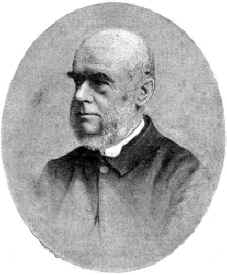 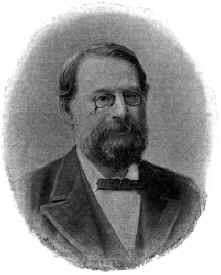 Charles
E. Ranken, Frederic H. Lewis Charles
E. Ranken, Frederic H. Lewis
George
A. MacDonnell, chess editor (writing under the pen name "Mars") of The
Illustrated Sporting and Dramatic News, responded to the limit of
fifteen players in his column of March
12, 1881. He argued that the match was no longer between club and club,
but between a limited number of members chosen for the convenience of
one of the sides.
He
thought that the match was as a national contest to decide the question
of supremacy in Great Britain.17
...
and therefore neither club is justified of itself in fixing the exact
number of players by whom it shall be championed. The quantity as well
as the quality of the players must be considered. The number of
representatives should not be limited by the number of champions which
either club may find it convenient or advantageous to send into the
field. The full strength of both clubs must be put forth. To put forth
less would be to leave the question of supremacy undecided by the issue.
The contest is to be a trial of strength, not between six or twelve
players on each side, but between two clubs. Neither club, therefore, is
entitled to limit the number of combatants. The City proposes twenty
players a-side, as being a manageable number, and in accordance with
precedent, as shown in the famous tourneys of 1870 and '71 between the
City and Westminster Clubs. That number the St. George's may propose
to increase, but certainly not to diminish, without acknowledging at
once its inferiority.
The chess writers who were member of the City of London Chess Club (George
A. MacDonnell, Robert S. Moffat, William N. Potter) generally criticized
the number of players. Chess editors connected to the St. George's
Chess Club (Charles E. Ranken, Wilhelm Steinitz, Johannes H. Zukertort)
paid no attention to the matter. The final number of competitors on each
side was sixteen. The adjustment, a few days before commencement of the
match, was a small consideration towards the City club.
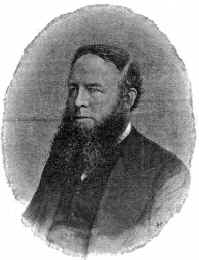 William
Wayte William
Wayte
Another
arrangement causing dissatisfaction was the adjudication of games by the
captains. Robert S. Moffat, the London chess correspondent of the Glasgow
Weekly Herald, called the rule unworthy of a contest between two
clubs of such high standing. He argued: "A
game of chess is an actual contest between two parties, and to submit it
midway to the judgment of any third parties, however competent and
disinterested, is as absurd as it would be to stop a battle at sunset,
in order that certain umpires might determine who had the best of it. I
hope the precedent set on this occasion will not be copied in future
matches."18
The
pairing of the first class players preoccupied the minds of many chess
lovers. The City club brought in Joseph H. Blackburne, Isidor Gunsberg,
MacDonnell, James Mason, and Potter. The leading players of St.
George's were Philipp Hirschfeld, John Owen, Ranken. Steinitz, William
Wayte, and Zukertort. Steinitz, however, refused to play. According to
MacDonnell, Steinitz thought that he had earned the higher honor of
umpire.19 His absence in play was much regretted.20
At
first, it was thought that the captains would perform the task of
ranking the players.21 Blackburne and Zukertort, however, did
not want to get their fingers burnt on this delicate matter and
circumvented the difficulties.
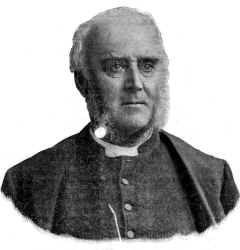 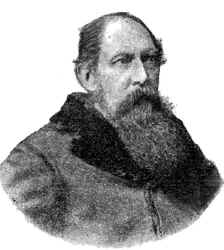 John
Owen, James I. Minchin John
Owen, James I. Minchin
The
pairing of the players was fixed on the day preceding the match.22
Minchin, secretary of the St. George's Chess Club, invented a special
design to avoid that anybody could take offence at the ranking. Steinitz
claimed in The Field of March
26, 1881:
It
was agreed that each side should furnish a private though final list,
only known to one or two members of their party, who had the authority
of ranging the players according to their presumable strength. A toss
should then decide which side should place the members of their team in
alphabetical order, while the opponents on each board were already
determined upon according to the original lists, which were afterwards
destroyed, the right of moving first being taken alternately on the line.
The issue of the toss made the alphabetical order obligatory for the
City Club.
This scheme was not always appreciated. MacDonnell, in The
Illustrated Sporting and Dramatic News of April 9, 1881, wrote that
he had no problems with the actual pairing of the first class players,
but he rejected the way it was executed:
It
was not the actual pairing of the players that I took exception, but to
the manner in which that pairing was accomplished. What that manner was
I am now officially informed is a secret that will never be divulged. A
secret! a mystery! Exactly; and being such I opposed it and denounced
it. But, argue my opponents, it was necessary that some such scheme
should be concerted in order not to wound the susceptibilities of the
City first-class players. Indeed! but I deny the existence of any such
susceptibilities. No men are less morbidly chary of their reputation
than the players in question. Moreover, they knew from the very outset
that they had all been bracketed together as equal by the captain of
their team; and even had it been otherwise, their only desire in the
matter was to uphold the honour of their club, and therefore were they
prepared to take any part in the contest which the accredited
representatives of the club might assign to them. But as a body they did
object to their rank in the chess world being decided by the hon.
secretary of the opposing club. That their rank was so decided is
evident from the statements put forth in a contemporary, which claims to
be inspired by that gentleman.
MacDonnell referred to the London
Figaro (March 9, 1881), in which Steinitz wrote: "... and
we learn that the St. George's will be represented on the first five
boards in the presumable order of strength by Messrs. Zukertort,
Hirschfeld, Owen, Wayte, and Ballard. On the City side there can be no
doubt that Mr. Blackburne will head the team. As regards second
place, the choice would unquestionably rest between Messrs. Mason and
Potter. Though the two players have made even games in a long match, the
former will probably be selected in preference on account of his having
won the first prize in two American tournaments, and in consideration of
the high place he obtained in the international tournament of Wiesbaden.
Mr. MacDonnell and Günzberg [sic] will, we understand, stand next in
the list."
The
continuation of MacDonnell's writing in The
Illustrated Sporting and Dramatic News of April 9, 1881:
One
conspicuous instance will suffice to show that the pairing of the City
players was not conducted impartially. Mr. Mason was placed above Mr.
Potter, although the equality of these players had been established in a
long and hard-fought match. The idea of arranging the players
individually in order of merit was an error, and the manner in which it
was carried out was, to say the least of it, invidious. The managers
seem to me to have hit upon the very plan that was most calculated to
wound susceptibilities, had they existed at all.
The
proper course seems to me a very simple one, and I am not a little
astonished at the failure of the authorities to discover it. The
representatives of the two clubs ought to have acquainted themselves
with the wishes of their respective players, and then when they met
together to pair them, to have seen how far these wishes were mutually
agreeable, and if they did not find them so, they might have decided by
lot which side was to have the choice of an opponent from the
corresponding class, the choice afterwards to alternate. The division of
the combatants into classes of course presented no difficulties, having
been often made in the various club tourneys in which they had taken
part. As it was, according to the writer in a contemporary to whom I
have already referred, some wonderful process was adopted in the pairing
by which "the responsibility for the rank of the players according to
strength was avoided," although he had previously stated "that the
opponents on each board were already determined upon according to the
original lists which were afterwards destroyed!" What a wonderful
magician must be the originator of the unknown scheme as to pairing. He
places the players in order of merit. He acquaints a foreign
professional with the arrangements. That professional published it in
his column. It is objected to, not as being in itself unfair, but as not
having been made by any qualified authority. He then withdraws his list,
and manufactures a machine which enables him, while pretending to ignore
it, to produce one that exactly corresponds with it, and all this, I was
assured, was done in a perfect legitimate manner.
The
match between Mason and Potter referred to was played in London in the
summer of 1879. This competition was abandoned after 21 games, each
player having scored 6½ points.
Moffat
shared MacDonnnell's opinion.23 He called the scheme "un-English,"
and hoped, in case of a new match between the two clubs, that the City
club would entrust the arrangement to a responsible committee which,
whatever it fixed up, would not be ashamed of its dealings.
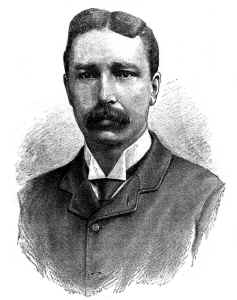 Walter
M. Gattie Walter
M. Gattie
Not
the
headquarters of the St. George's club, but Willis's Rooms at King
street accommodated the struggle between the two London clubs. The new
place was chosen because of its size: Willis's Rooms was bigger than
St. George's place of residence. Whether Willis's Rooms gave the
players and spectators enough elbow-room is doubtful. The place was
overcrowded.24 MacDonnell wrote – he was five minutes late
- that he could scarcely pilot his way through the crowd to his table.
He estimated that more than two hundred spectators visited the room.25
Moffat wrote:26
The
accommodation for the match must be described without qualification as
bad. The admission of visitors was strictly limited, yet the room in
which the play took place was crowded to excess. Whether the tables were
arranged well or ill I could not tell, as I had not an opportunity of
forming a distinct idea of the size and shape of the room, seeing the
strategic exertions required of visitors in order to walk through it
were about as those demanded of the winners at the first-class boards. I
did not play the game with sufficient success to get access to every
corner, but where I did penetrate an atmosphere dense, heated, and
stifling with the fumes of tobacco damped my ardour even as an on-looker,
and made me glad I did not occupy a more responsible position.
The Chess Monthly (April 1888, pages 225-226) claimed that twice the
space would not have been sufficient to accommodate the spectators.
The
room was divided in three rows, two of five tables each, and one of six,
with just sufficient space to move about. Especially the crowd that
gathered round the board at which Zukertort and Blackburne were playing
was dense.27
MacDonnell
had foreseen the bustle, and suggested alternative hours of play, which,
he believed, would better accommodate both the players and the
spectators.28
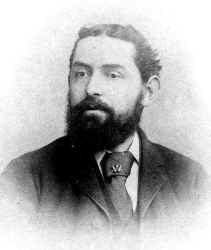 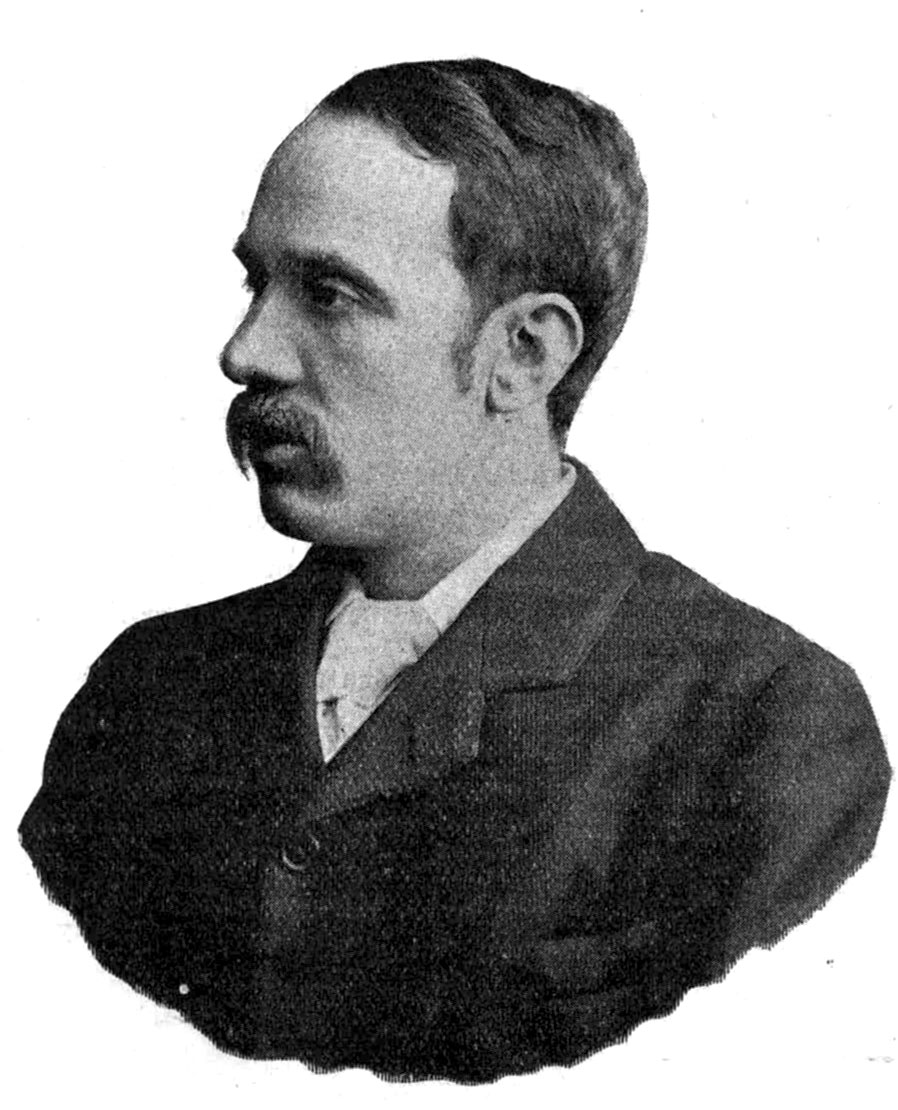 George
C. Heywood, Frederick W. Lord George
C. Heywood, Frederick W. Lord
The
sixteen players representing St. George's were (in alphabetic order):
W.F. Ball, William R. Ballard, Walter M. Gattie, William Gunston,
Hirschfeld, Frederic H. Lewis, W.A. Lindsay, Charles Marrett, Minchin, Charles
Puller, Owen, Ranken, David Salter, J.H. Warner, Wayte and Zukertort.
Acting for the City club were John Baddeley, Blackburne, Theodore Block,
Samuel W. Earnshaw, Gunsberg, Frank Healy, George C. Heywood, James A.
Huckvale, Jackson, Franciscus G. Janssens, Frederick W. Lord, MacDonnell,
Mason, Potter, Samuel Stevens and W. Elliot Vyse.
The
match turned out to be a titanic struggle, which was decided in favor of
the St. George's Chess Club. Steinitz reported in the London
Figaro (March 30, 1881):
The
play was worthy of the occasion, and of the great reputation of the
chief representatives on each side. As will be seen from the score-list
below, the City Club had the best of the struggle on the boards on which
the strongest players were engaged. Only Herr Zukertort succeeded in
beating Mr. Blackburne one game for the St. George's; while Messrs.
Mason, Potter, and MacDonnell for the City of London beat their
respective opponents, Messrs. Hirschfeld, Owen and Wayte, and Herr
Günzberg [sic] made even games with Dr. Ballard. The result of the play at the other
boards gave the St. George's Club ultimately the advantage, but only
gradually and slowly. Not until about five hours' play was the victory
of the St. George's secured by a sufficient majority to place them
ahead even if they lost all the games which were pending at the time.
The arrangement was that no second game should be commenced after half
past nine o'clock, and that the match should proceed until midnight.
Mr. Lord and Ranken, as well as Messrs Mason and Hirschfeld, played each
one single game throughout the whole sitting. All the games were decided
with the exception of the second between Messrs. Potter and Owen, which
was left unfinished, but was to be played out on the following Saturday.
Below
is the score list (City club - St. George's club) Steinitz referred to.
The four draws did not count:
|
Baddeley - Warner
|
1-1
|
|
Jackson -
Gunston
|
2-0
|
|
Blackburne - Zukertort
|
0-1
|
|
Janssens - Minchin
|
½-1½
|
|
Block - Puller
|
1½-½
|
|
Lord - Ranken
|
½-½
|
|
Earnshaw - Lewis
|
0-2
|
|
MacDonnell - Wayte
|
1-0
|
|
Gunsberg - Ballard
|
1-1
|
|
Mason - Hirschfeld
|
1-0
|
|
Healey -
Lindsay
|
1-1
|
|
Potter
- Owen
|
1-0
|
|
Heywood - Ball
|
½-½
|
|
Stevens
- Gattie
|
0-2
|
|
Huckvale - Salter
|
0-2
|
|
Vyse
- Marrett
|
0-1
|
|
|
|
|
Total
|
9-12
|
The
second game between Owen and Potter was played out on Saturday, March
26, 1881, and resulted in favor of Potter. The win was not added to the
score of the City club. Potter, in Land
and Water (April 2, 1881), explained:29
It,
however, seems to have been generally agreed or understood that the
score arrived at on the Thursday night was final and not to be disturbed.
While accepting this understanding, we find it difficult to understand
why the City side consented thereto. This game was, according to the
conditions, duly commenced before half-past nine o'clock p.m. Not
being finished when 12 o'clock arrived, it was, in accordance with the
conditions, submitted to the captains, Messrs. Zukertort and Blackburne,
for their adjudication They, after examining the position, expressed
their unwillingness to adjudicate, and desired that the game should be
played out. It is true that Mr. Potter offered Mr. Owen a draw, but this
offer was refused, as Mr. Owen considered that he had the superiority.
In this impression he was mistaken, as we made manifest by a tolerably
complete analytical examination between the players themselves after the
conclusion of the game.
St.
George's
victory (or the defeat of the City club) was analyzed in different
papers. Potter concluded that the St. George's team mainly owed the
victory to Lewis, Salter and Gattie, who each won two games.30
He
continued: "Mr. Lewis was far too powerful for Mr. Earnshaw. The
latter is not a good match player, a fact made manifest by his play in
the last Counties Chess Association meeting in London, and the quick
time limit doubtless harassed him considerably, for he is naturally an
exceedingly slow player. Mr. Huckvale used to be an exceedingly strong
amateur, and in former times we should have considered him decidedly
worthy to meet an opponent of Mr. Salter's strength. His defeat is to
be attributed to his having been for the last three or four years almost
totally out of practice. Mr. Stevens's show in the match we find it
somewhat difficult to understand. Being as quick-sighted as skillful he
had nothing to fear from a twenty move time limit. We have not seen his
games with Mr. Gattie, but should they come across our observation we
expect to find that he indulged in that fantastical unsound style which
has so often been the cause of his losing games and prizes. It would
appear that as a matter of fact he had a dead win in his first game with
Mr. Gattie."
Potter
gave special attention to Blackburne's performance. The City player
could have drawn his game with Zukertort, but persisted in trying to
win, and so came to grief. Potter noticed that this misfortune had often
before happened to him, especially in his match with Steinitz in 1876.
The chess editor of Land and Water
also praised Blackburne's antipathy to drawing games: it implied a
good fighting spirit.
MacDonnell,
discussing the outcome of the match, wrote – as Steinitz had done –
that the first class players of the City club out-classed their St.
George's rivals. Furthermore, he pointed out that two of the St.
George's representatives were old City members: Ballard and Hirschfeld.
He argued: "... and had even one of them been ranged on the side of
the City it must have materially affected the result by altering the
pairing along the whole line."31 According to MacDonnell,
these facts materially lessened the glory of the victors.
The
Glasgow Weekly Herald (April
2, 1881) offered the following account:
Now
let us look at the result. As a real trial of strength it is somewhat
confused by the alternative of playing one or two games between each
pair of players. This may be shown in two ways. First, without regard to
the number of games won by each player. Here is a list of the victors on
each side:
St.
George's Club – Zukertort, Minchin, Salter, Lewis, Gattie, and
Marett – 6.
City
Club – Potter, MacDonnell, Mason, Heywood, and Jackson – 5.
Can
anyone doubt where the preponderance of first-class strength in these
two lists lies?
Again,
take the winners of two games on each side, leaving out Jackson, for the
City and Gattie for the St. George's as ties, we have the whole
victory accounted for in the following list: Lewis, 2; Salter, 2.
A
casual victory of this kind is never very decisive in any case, and the
probability is that had the same players played a return match on the
following day, the result in half the cases would have been wholly
different.
Finally,
two more details of the match: for some period it
was doubtful that Mason would take part. He was seriously ill, but
recovered just in time to be present.32 As written above,
Boden acted as umpire, but no case arose for his decision. As MacDonnell put it: "He had nothing to do, and he did it admirably."33
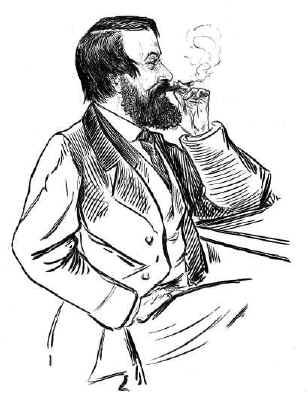 Samuel S. Boden Samuel S. Boden
Twelve
games and a position have been found.
Johannes
H. Zukertort
- Joseph
H. Blackburne
1.
e4 c5 2. Nc3 e6 3. Nf3 Nc6 4. d4 cxd4 5. Nxd4 Bb4 6. Ndb5 Nf6 7. a3
We
thought well of this move, which was introduced by Englisch against L.
Paulsen in one of the German tournaments. We understand that the latter,
with his usual predilection for the two bishops, retreated his king's
bishop to e7, and White thus obtained the superiority of position. But
the mode of defense adopted by Blackburne in the present game and in his
match with Gunsberg seems to give the second player at least an equal
position in the opening.
7.
... Bxc3+ 8. Nxc3 0–0
Here
we prefer d5 at once, which will most probably lead to the same kind of
game as the one actually obtained.
9.
Be2
While
now White might have altered the whole aspect of the situation by f4,
with the object of immediately advancing pawn to e5, and placing the
king's bishop in an attacking post against the adverse king's side at
d3.
9.
... d5 10. exd5 exd5 11. Bg5 Re8
A
good move in Mr. Blackburne's usual attacking style. He might have also
equalized the game by d5, whereupon the game might have proceeded thus:
11. ... d4 12. Ne4 Qa5+ 13. Bd2 (Best; for if 13. b4 Black
will obtain the advantage by 13. ... Qe5, which compels the exchange of the knights, and
enables him to stop the adverse castling by Re8) 13. ... Qd5, even game.
12.
0–0
He
could not win the pawn without subjecting himself to a strong attack. In
reference to the course of exchanging the knight followed by knight
takes pawn, which apparently leaves Black exposed to the loss of the
exchange, Mr. Blackburne communicated to us the following fine variation:
12. Bxf6 Qxf6 13. Nxd5 Qxb2 14. Nc7 Qc3+ 15. Kf1 Rxe2 16. Kxe2 Nd4+ 17.
Kf1 Bf5, and wins, for the knight has no escape, and if 18. Nxa8 then
follows 18. ... Bxc2 19. Qe1 Bd3+ 20. Kg1 Ne2+ 21. Kf1 Nc1+, and mates
in a few moves.
12.
... d4 13. Bxf6 Qxf6 14. Nd5 Qd6
We
prefer Qd8, which would enable Black at any time to take the queen's
bishop's pawn in passing, whenever it advanced in support of the knight.
15.
Bf3 Be6 16. c4
While
now the numerical superiority of White's pawns on the queen's wing is
established, for the pawn cannot be captured in passing, on pain of the
queen being lost by Nf6+.
16.
... Rad8 17. Re1
Doubtful.
Pawn to a6 at once seems better, for the queen is not well placed at her
present post.
17.
... Qc5 18. Rc1 a6
Necessary,
in order not to allow the adverse knight's pawn to come up to b5
unchallenged, and thus to compel the removal of the knight which
supports Black's queen's pawn.
19.
b4
Mr.
Zukertort rightly considers this precipitate advance the source of his
later difficulties. As the adverse queen could not well stop at her
present post, it was injudicious to drive her at once to a square whence
she could support the entrance of the knight at e5. Pawn to g3 was
better at this juncture.
19.
... Qd6 20. g3 Ne5 21. Bg2 b5
Mr.
Blackburne shows excellent judgment in this advance, which liberates an
apparently formidable hostile pawn. He had well calculated that his own
queen's pawn, though isolated, ought to be a very good match for White's
passed queen's bishop's pawn. The failure of his strategy is caused by
subsequent shortcomings in tactics.
22.
c5 Qb8 23. c6
Mr.
Zukertort's boldness apparently increases in danger. His course was most
perplexing in play over the board, though we have no doubt it will not
stand analysis. There was, however, no other satisfactory plan. The
retreat of the knight to f4 would have left the adversary with the
better game after posting his bishop at c4; and Qxd4 would have lost
clearly, for the bishop would take the knight, followed by Nf3+ if
bishop retook.
23.
... Rxd5
Best,
and good enough for winning purposes if properly continued. It may be
observed that he could not evade the responsibility of capturing the
piece by Qd6; for White would then equally advance the bishop's pawn to
c7, followed by pawn to f4, whereupon the White rook could enter at c6,
for Black could not take on account of the impending Ne7+.
24.
c7 Qc8
The
only move again. The queen could not attempt to protect the rook on the
white diagonal, for White would then capture the knight with the rook.
25.
f4
White
makes the most of the complications he has purposely created; but he
evidently could not take the rook at once, as the adverse knight would
afterwards threaten the terrible check at f3.
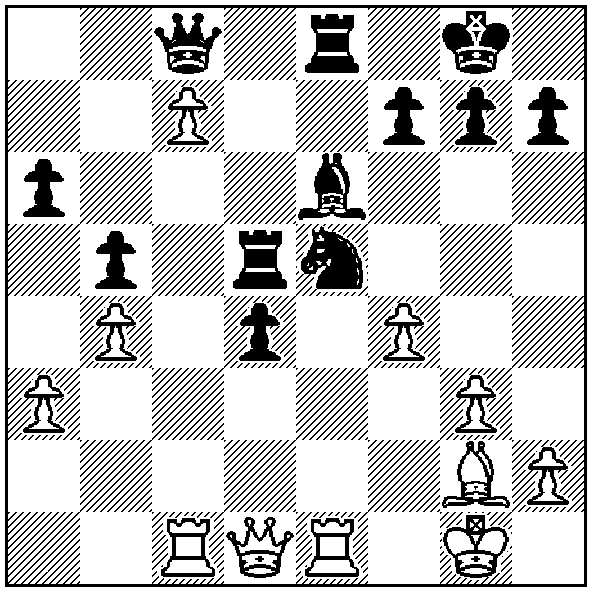
25.
... Nc4
This
changes the issue entirely, while, by offering to give up the piece in
most variations, Black would maintain sufficient superiority to insure
winning in the end. Bg4 was the correct play, and we can only give the
principal variations, which, as far as we can judge, comprise the most
difficult lines of play on either side. Supposing 25. ... Bg4 26. Qb3 (or
26. Bxd5 Bxd1 27. Rxe5 Rxe5 (Black
might also win by removing rook to f8) 28. Bb7 Re1+ 29. Kf2 Bf3 30.
Bxc8 Rxc1 31. Kxf3 Rxc7 32. Bxa6 Ra7 33. Bxb5 Rxa3+ 34. Ke4 Rb3, and
should win; 26. Qd2 Nf3+ 27. Bxf3 Rxe1+ 28. Qxe1 (or
28. Rxe1 Bxf3 29. Qc1 d3 30. Re8+ (if Qc6, the answer is Re5) 30.
... Qxe8 31. c8Q Rd8, followed by d2, gaining one of the queens,
and remaining with a clear piece ahead)
28. ... Bxf3 29. Qe7 Bg4 30. Re1 Be6 31. f5 Rd7 32. Qg5 f6,
and wins; 26. ... Rd7 27. Rxe5 Rxe5 28. Bb7 (if fxe5, Black evidently
has the superiority with his passed queen's pawn, after taking the
bishop's pawn) 28. ... Rxc7, and wins, for the bishop dare not take the
queen, or mate follows in a few moves; and if Rxc7, Black first gives
two checks with his rook at e1 and e2. We may also observe that Ng4
instead of the move in the text, would also have lost, for White would
first take the rook, followed by queen takes knight at once, if bishop
retook.
26.
Bxd5 Bxd5 27. Rxe8+ Qxe8 28. Qxd4 Bb7
Be6
would not have saved the game either, e.g.:
28. ... Be6 29. Qd8 Qf8 (if Kf8, White replies Re1, threatening Rxe6,
and also f5) 30. Rd1 Nb6 (there seems nothing better; for if g6, the
answer is Qf6, and if then the knight attempts to cover at d7, the rook
may take it off, followed by c8 queening) 31. Qb8 Nd7 32. Qb7, and wins.
29.
Qd8 Qf8
If
Kf8, White won by Re1.
30.
Re1 Nd6 31. Re7
Mr.
Zukertort made a shrewd guess of the chances of succeed in actual play,
when he entered on his sacrificing policy on the 23rd
move; and he has supported his good luck with exact scientific
calculations since the adversary let his opportunity slip on the 25th
move. Resigns.
Sources:
The
Field,
April 2, 1881 (notes by Wilhelm Steinitz), The
Chess Player's Chronicle, April 12, 1881, The
Chess Monthly, April 1881, pages 246-247.
James
Mason
- Philipp
Hirschfeld
1.
f4 e6 2. Nf3 d5 3. b3 Be7 4. Bb2 Bf6
Though
it is good to be able to oppose bishop to bishop in this opening, it is
rarely necessary to do so at such an early stage as the present. Black
could well have played Nf6, reserving the text move until circumstances
might render it more advisable.
5.
Nc3 c5 6. e3 Nc6 7. d4
This
brings about what is so often held up as a source of weakness to the
first player, viz., the abandonment of all pawn-guard, or control over
the two important squares, king's third and fourth. But, it seems to us,
the weakness is more apparent than real; is in fact a theoretical one
merely, which rarely needs be taken account of in actual play.
7.
... cxd4 8. exd4 Nge7 9. Qd2 a6 10. Be2 Nf5 11. Nd1
White
has embarrassed as to the disposal of his king's bishop. This move was
made with the view of posting it at d3; its effective parry of the
manoeuver presently executed by Black was likewise a point in its favor.
11.
... Bh4+
We
do not see what advantage could be sought in this, unless Black wished
to exchange the bishop, which was not particularly well placed at f6.
Pawn to g6, b6, or Bd7 looks better.
12.
Nxh4 Qxh4+ 13. Nf2 Qd8 14. 0–0 0–0 15. Rad1 b6 16. Ng4
This
and the next two moves appear to be made with little object, except that
through them he is enabled to play Bd3. There was not much to be done
otherwise.
16.
... Bb7 17. Ne5 f6 18. Nf3 Qc7 19. Bd3 Nh6
Time
was pressing just about here, or Mr. Hirschfeld might have chosen d6,
instead of this square, for the knight.
20.
c3 g6 21. Rc1 Qd7 22. Rfe1 Rfe8 23. Re2 Nf7 24. Rce1 Nd6 25. Ba3 Rad8
A
faulty play. Re7, though not a very attractive move, seems the best to
guard against the contemplated advance of White's king's bishop's pawn -
an advance from which Black should have much to fear, and the full force
of which he overlooks, at least for the moment.
26.
Bxd6 Qxd6 27. f5 e5
It
is plain that the capture of the pawn would have subjected him to an
attack of a very damaging character. Suppose 27. gxf5 28. Bxf5 Bc8 29.
Qh6 Re7, and White can take the bishop's pawn without danger.
28.
fxg6 Kg7 29. gxh7 e4 30. Nh4 Bc8 31. Re3
And
this appears to be an error on the part of Mr. Mason. Why not simply
take the queen's rook's pawn, giving him an almost certain win by force
alone, not to speak of position, which would still remain in his favor?
The move the rook, it is true, threatens to attack the king, direct; but,
as the subsequent play discloses, there is very little in it.
31.
... Ne7 32. Rg3+ Kxh7 33. Qe2 Kh6 34. Qe3+ Kh7 35. Qe2 Kh6 36.
Qd2+
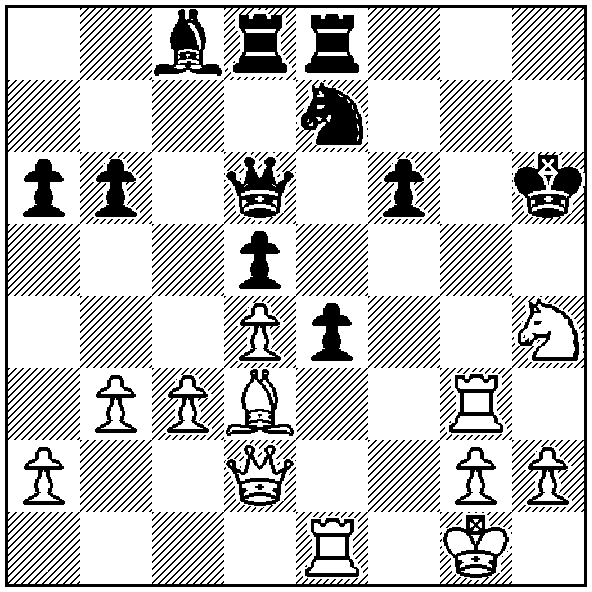
36.
... Kh7
Black
singularly enough has but this defense of moving his king back and forth;
but it is an ample one, and brings White's schemes to naught.
37.
Bb1 Rg8 38. Ree3
Notwithstanding
the extra pawn White has little prospects of winning, now that Black
forces an exchange of rooks.
38.
... Rxg3
If
Qf4, to take knight, he would lose on account of the reply Rxe4 - as 38.
... Qf4 39. Rxe4 Qxd2, and White mates in two moves.
39.
Rxg3 Rg8 40. Rxg8 Nxg8 41. Qe2 Kh6 42. g3 f5
Weak
play, which gives White the advantage once more. Had Black kept his pawn
at f6 - thus keeping the line open for his own bishop and preventing the
White queen from going to g5 - it is not at all probable that the
contest could result in anything else than a draw.
43.
Qe3+ Kh7 44. Qg5 Nh6 45. Bc2 b5 46. Bd1 Qe6 47. Bh5
The
appearance of this bishop settles matters. White must win now.
47.
... Nf7 48. Bg6+ Kg7 49. Qxf5 Qxf5 50. Bxf5 Bxf5 51. Nxf5+
Kf6 52. Ne3 Ke6 53. h4 Nd8 54. Kf2
Nc6 55. b4 a5 56. a3 axb4 57. axb4 Ne7 58. g4 Ng6 59. Kg3 Ne7 60. h5 Kf6
61. Kf4 Ke6
62. g5 Kf7 63. Ke5 Kg7 64. Ke6 Kf8 65. g6 Ke8 66. g7 Ng8 67. Nxd5
Nh6 68. Nf6+ Kd8 69. Nxe4,
and
Black resigns.
Source:
The
Chess Player's Chronicle,
April 5, 1881 (notes by James Mason).
John
Owen
- William
N. Potter
1.
b3 Nf6 2. Bb2 e6 3. e3 b6 4. Nf3 Bb7 5. Be2
Though
a continuation often adopted in openings of this kind, and not without
some reason, yet its effect is frequently the loss of a move, for d3 is
the king's bishop's point for attacking purposes, and it generally has
to move there sooner or later. Consequently White's play here should be
5. d4, to be followed by Bd3.
5.
... d5 6. d4 Bd6 7. Nbd2
This
move, like the fifth, aims at a compact coherent position, and will
often be made on that ground. c3 is, however, the knight's best square
in such openings; though not forgetting that the queen's bishop's pawn
must not be blocked up. We therefore favor 7. 0–0, intending
afterwards c4 and Nc3.
7.
... 0–0 8. 0–0 c5 9. c4 Nc6 10. Rc1 cxd4
In
games of this kind it is always a question as to when one of these pawns
should be taken, and who should do it. We are inclined to think that
Black acts correctly here.
11.
exd4 Rc8 12. Bd3 Bf4
Which
seems to give Black a something of advantage.
13.
g3 dxc4 14. bxc4 Bh6
Whether
this or Bxd2 be preferable may be doubtful. A good principle to go by is
not to exchange pieces unless there be a clear reason for it.
15.
Bb1
White
does not sufficiently realize the weakness of this position. The best
resource here is to take the queen's rook back to its own square.
15.
... Na5 16. Ne5 b5 17. f4
This
shuts out the adverse bishop, but 17. cxb5 Qd5 18. f3 affords a better
chance, even though Black can answer with Be3+, followed by Bxd4.
17.
... Nxc4 18. Ndxc4 bxc4
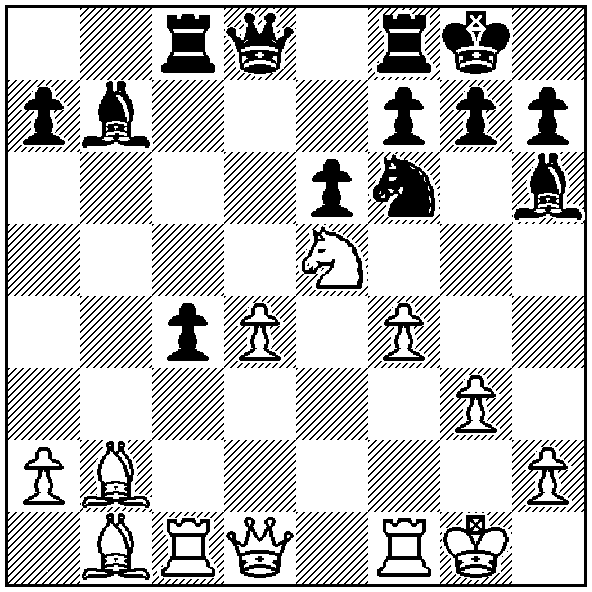
19.
Rc3
What
to do here is very far from clear. Pawn to g4 is obviously futile. We
suppose he should play either Bc3 or Ba3.
19.
... Qd5 20. Nf3 Rfd8 21. Re1 Qb5 22. Qc2 g6 23. Re5
Ne5
is advisable, so as to obtain some breathing time.
23.
... Nd5 24. a4
A
move which Mr. Owen severely censured afterwards, and certainly it
serves no good purpose. Nevertheless, the game is practically lost at
this point, for if 24. Ra3, then either Bg6 or Qc6 would give Black a
winning advantage.
24.
... Qc6 25. Ra3 c3 26. Bc1 Nb4 27. Qe4 c2 28. Bxc2
If
28. Qxc6, Black may reply by cxb1Q, or by simply taking off the queen by
bishop.
28.
... Nxc2
White
resigns.
Sources:
Land
and Water,
April 2, 1881 (notes by William N. Potter), The
Chess Player's Chronicle, April 19, 1881, The
British Chess Magazine, May 1881, pages 162-163.
William
N. Potter
- John
Owen
1.
e4 b6 2. d4 Bb7 3. Bd3 e6 4. Ne2
Either
this or h3 is the right square for the knight in this opening; f3 should
be avoided, as it is essential for White to be able, on occasion, to
sustain the center pawns with king's bishop's pawn.
4.
... d5 5. e5
If
we compare this position with a kindred one in the Sicilian Game, in
which e5 is disadvantageous for White, we shall find two important
differences: the Black queen's bishop is worse placed than at home,
where he has the prospect of deploying at d7; and the queen is also shut
out from b6.
5.
... c5 6. c3 Qd7
This
move with the 9th, 12th and 13th forms part of Mr. Owen's system in
defending his favorite opening. Before the present game was played he
thought the result favorable to the second player. Whether he thinks so
still, we do not know; it is at least a noteworthy manoeuver deserving
of recollection.
7.
0–0 Be7 8. Be3 Nc6 9. Nd2 Bd8 10. a3 Nge7 11. f4 c4 12. Bc2 b5 13. g4
White
evidently sees whither his opponent is tending, and cries "Who's
afraid?"
13.
... Bb6 14. Ng3 g5 15. Nh5 0–0–0 16. fxg5 Nxe5
The
attack on this pawn was clearly the object of Black's far-reaching
scheme; to us, we must confess, it appears not worth the candle.
17.
Qe2 Nd3 18. Nf3
All
sound and well calculated. He does not want to take the pawn, foreseeing
it must fall in the end.
18.
... e5 19. Nf6 Qc6 20. Bxd3 cxd3 21. Qf2 Ng6 22. h4 h6
Nothing
comes of the attack on the open rook's file. We should have preferred
e4; and whether White replied with Ne5, Nh2 or h5, Black's prospects
would have been better than they now turn out.
23.
h5
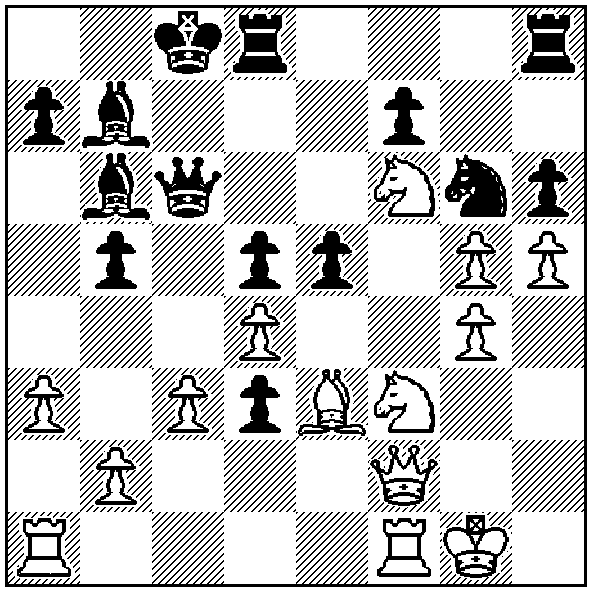
At
this point time was called, and the game scared a draw, making the St.
George's Club 12 to 9. The players afterwards finished it for their own
satisfaction, Black fancying - we cannot imagine why - that he had the
better game.
23.
... hxg5 24. hxg6 Qxf6 25. Nxe5 Qg7
Qxf2
was no better. Whether he tried to save the exchange or not, he could
not afterwards protect his ragged pawns.
26.
Qf5+ Kb8 27. Nxf7 Rh3 28. Nxd8 Rg3+
Mr.
Potter observes, in the only note he has appended to the score, that if
Black had played 28. ... Rxe3 he intended Nc6+, forcing the exchange of
queen's and proposing to win with the advanced knight's pawn. If 28. ...
Bxd8, it seems that White could equally win by Qe5+, letting the bishop
go.
29.
Kf2 Bc7 30. Ne6,
and
wins.
Source:
The
British Chess Magazine,
May 1881, pages 163-164 (notes by William Wayte).
William
Wayte
- George
A. MacDonnell
1.
e4 b6 2. d4 e6 3. Bd3 Bb7 4. Nf3 c5 5. c3 Nf6 6. Qe2 Be7 7. 0–0 Nc6 8.
a3
Worse
than useless; he ought to have played out the queen's bishop.
8.
... 0–0 9. Be3 Qc7 10. h3 d6 11. Nbd2 Rad8 12. b4
A
very good move; as whether Black takes the pawn or not he gets an
inferior position.
12.
... Nd7
To
strengthen the queen's bishop's pawn and prepare for the advance of
king's bishop's pawn.
13.
Nb3 Ndb8
A
bizarre but by no means weak move, played in expectation of Black
replying by pawn takes pawn.
14.
b5
Much
better than capturing bishop's pawn, which would have only weakened his
position without securing any material advantage, thus: 14. bxc5 bxc5
15. dxc5 d5, and White's pawn at c5 must eventually fall.
14.
... Na5 15. Nxa5 bxa5 16. a4 c4
A
move that exercises a very potent influence upon the game.
17.
Bb1
Bc2
seems best; if Bxc4 Bxe4, threatening then to play Rc8.
17.
... Nd7 18. Nd2 Nb6 19. Bc2 f5 20. f3
To
curtail the diagonal power of his adversary's queen's bishop.
20.
... f4 21. Bf2 Kh8 22. Kh1 Rc8
To
relieve the queen from guard.
23.
g3
Injudiciously
played in the hope of getting up an attack with rooks on king's knight's
file.
23.
... e5 24. gxf4
Pawn
to g4 would have been much better.
24.
... exf4 25. Rg1 Rf6 26. Qf1 Rcf8 27. Rg2
This
manoeuver to protect the rook's pawn is unsound; probably his best
course was e5 followed by Qg2.
27.
... Rh6 28. Rh2 Bh4
The
only move to enable him to retain his hold on the rook's pawn.
29.
Bxh4 Rxh4 30. Qf2 Qe7 31. Rg1 Bc8 32. Qf1 Rf6
Black
now sacrifices the queen's bishop's pawn with great advantage.
33.
Nxc4 Rfh6 34. Nxb6
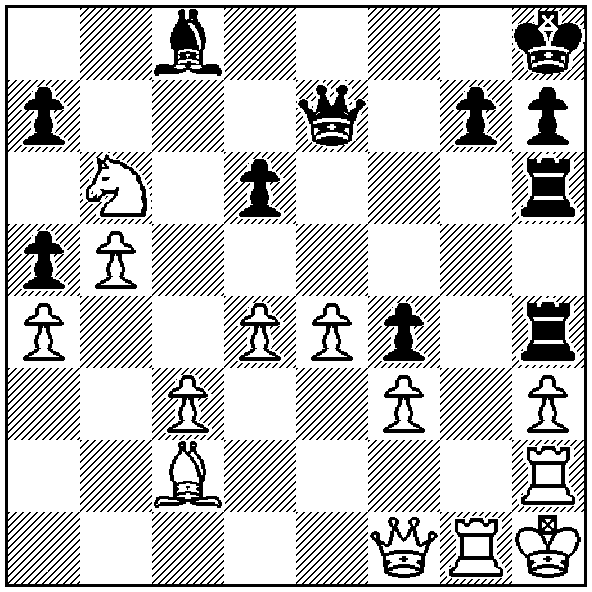
34.
... Rxh3
Black
has now a forced won game.
35.
Rgg2 axb6 36. Qe2
Fatal,
but it is questionable whether he has any saving moves.
36.
... Bg4
The
decisive stroke.
37.
Qc4
Taking
bishop with rook was probably best; but in any case Black wins easily.
37.
... Rxh2+ 38. Rxh2 Rxh2+ 39. Kxh2 Qh4+ 40. Kg1 Qg3+ 41. Kf1 Qxf3+ 42.
Kg1
Black
mates in four moves.
Source:
The
Illustrated Sporting and Dramatic News,
April 9, 1881 (notes by George A. MacDonnell).
Isidor
Gunsberg
- William
R. Ballard
1.
e4 e5 2. f4 exf4 3. Nf3 g5 4. h4 g4 5. Ng5 h6 6. Nxf7 Kxf7 7. d4 d6
A
very ineffective defense. Either d5 or c6 should be played.
8.
Bc4+ Kg6
A
bad place for the king in every form of the Allgaier-Thorold. He should
go to g7.
9.
Bxf4 Nf6 10. Qd3
10.
Nc3 is decidedly better, to be followed, if Nc6, by 11. Qd2; and if Qe8
by 11. Qe2.
10.
... Qe8 11. Nc3 Nc6 12. h5+
Doubtless
best, as otherwise the results of his 10th move will begin to tell
against him.
12.
... Nxh5 13. Rxh5 Nb4
I
doubt if this be really requisite.
14.
Qe2 Kxh5 15. a3 Nc6 16. 0–0–0 Kg6
I
think there is time for Bg7. A very advisable move to make.
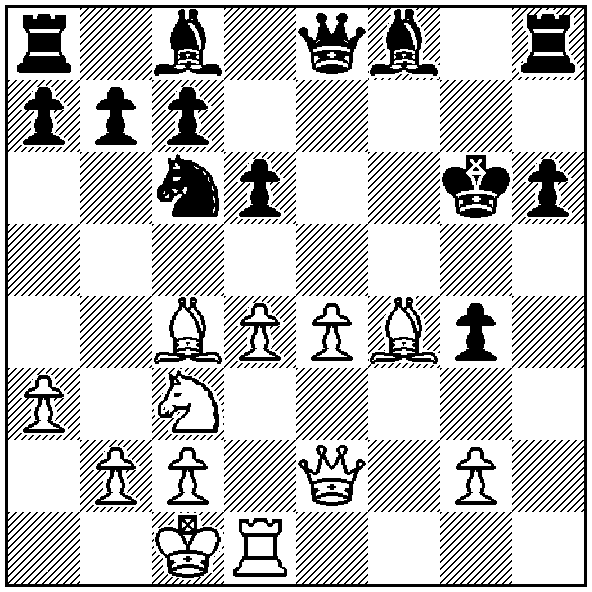
17.
Nd5
A
frightfully strong move.
17.
... Rh7
I
still prefer Bg7, as loss of some kind cannot be avoided. His 18th move
makes matters worse, though play how he might he would sustain serious
wounds. The editor binds me to extreme brevity, so I cannot particularize further.
18.
e5 Rf7 19. Bd3+ Kg7 20. Nf6 Nxd4
A
blunder, but nothing can save the game at this point. If 20. ... Rxf6,
he loses his queen. If 20. ... Qe7, then 21. Bxh6+ Kh8 (forced) 22.
Bxf8, winning. If 20. ... Qd8, then 21. Bxh6+ would still win, though
21. Bxh6+ followed by Qg6 is even more effective. If 20. ... Qe6, then
21. d5 Qe7 (Nd4 is obviously useless) 22. Bxh6+, as above.
21.
Nxe8+
Resigns.
Sources:
The
Illustrated London News,
April 2, 1881; The Chess
Player's Chronicle, April 19, 1881 (notes by William N. Potter); The
British Chess Magazine, May 1881, pages 165-166.
Frederick
W. Lord
- Charles
E. Ranken
1.
e4 e5 2. Nf3 Nc6 3. Bb5 Nf6 4. Nc3 Nd4 5. Bc4
Good
as against 3. ... Nd4, and equally satisfactory in the present position.
5.
... Nxe4 6. Nxe4
We
consider that White could here beneficially adopt a course that in most
cases is far from good, viz., 6.
Bxf7+ Kxf7 7. Nxe4 d5 8. Nc3 Kg8 (Black appears to have nothing better)
9. h3 with a comfortable advantage. The text move, however, should also
yield some superiority.
6.
... d5 7. Nxd4
Altogether
inferior to 7. 0–0 Nxf3+ 8. Qxf3 dxc4 9. Qg3, followed by Re1. If
Black 7. ... Bg4, then 8 Be2.
7.
... exd4 8. Bxd5
There
is much to be said for 8. Bb3 dxe4 9. Qh5 Qe7 10. 0–0. In fact, we
should prefer this line of play rather than concede to Black the safe
pull he must otherwise obtain.
8.
... Qxd5 9. d3
As
a matter of mere taste we prefer 9. Qe2.
9.
... Bf5 10. 0–0 0–0–0 11. Qf3 h6 12. Bf4 g5 13. Bg3 Be7 14. Qe2
Be6
We
favor Rde8.
15.
Rae1 h5 16. Nd2 Bb4
Though
circumstances are somewhat changed, we still fancy Rde8; not, however,
that we have otherwise anything to say against the text move, which
fully maintains the superiority achieved by Black's excellent play
hitherto; but the move we indicate would keep White involved in various
embarrassments, and would avoid exchanges.
17.
a3 Bxd2 18. Qxd2 f6 19. f3 h4 20. Bf2 Bf5 21. Re2
Not
well considered. His best chance here is Re7.
21.
... h3 22. g3 g4
This,
the last of a series of vigorous blows, calls upon White to submit to
some loss.
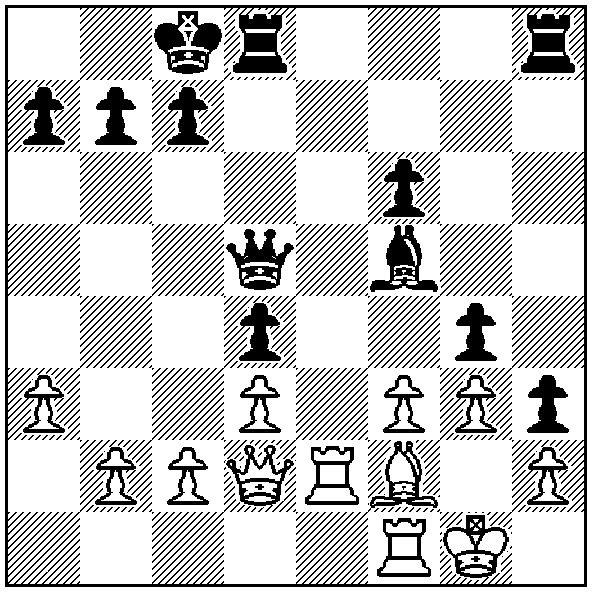
23.
Re4
Selected
with first-rate judgment, and making the game as difficult as may be for
the opponent, who, it is obvious, is practically compelled to accept,
even if willing to refuse what is offered to him.
23.
... Bxe4 24. fxe4 Qe6
According
to our idea Qc6 is better.
25.
Be1 Rh5
Here
we prefer Rhg8, and not merely in the present but in any position that
might have arisen.
26.
Qf4 f5
All
part of the same idea, but it is a bad one, and should not be persisted
in. A game of this kind demands the utmost patience. Though hard work is
now cut out for him, yet by playing Rd6 he might still look for an
ultimate win.
27.
exf5 Qe2 28. Qd2 Qg2+ 29. Qxg2 hxg2 30. Rf4 Rdh8 31. Rxg4 Rxf5
An
examination of Rxh2 leads to the conclusion that White has nothing to
fear there from.
32.
Kxg2 Re8 33. Re4 Rfe5 34. Kf3 Rf8+ 35. Kg2 Rxe4 36. dxe4 Kd7 37. Bd2 c5
38. h4 c4 39. Bf4 Ke6 40. Kf3 b5 41. Ke2 a5 42. b4 axb4
Pawn
takes pawn en passant, followed by Rc8, seems more threatening, but with
correct play on White's part we do not find that Black could force a win
thereafter, while, on the other hand, we see reasons for supposing that
he might incur serious risks in trying to do so. However, here, as in
other parts of this hard-fought endgames, an exhaustive analysis,
lasting, like one that Horwitz conducted, for about three weeks, if our
memory serves us correctly, might be able to deduce a victory for one
side or the other. Most persons will, like ourselves, be pleased to find
a capital over-the-board fight ending in a conclusion honorable to both
sides.
43.
axb4 Ra8 44. h5 Ra2 45. Kd1 Ra1+ 46. Kd2 Rh1 47. h6 Rh2+ 48. Kc1 Kf7 49.
Be5 Rxh6 50. Bxd4 Ke6 51. Kd2 Rg6 52. c3 Rxg3 53. Ke2 Kf7 54. Kf2 Rh3
55. Kg2 Rd3 56. Kf2 Kg6 57. Ke2 Kg5 58. Be5 Kg4 59. Kf2 Rd2+ 60. Ke3,
and
here abandoned as drawn.
Sources:
Land
and Water,
April 16, 1881 (notes by William N. Potter); The
British Chess Magazine, May 1881, pages 166-168.
Franciscus
G. Janssens
- James
I. Minchin
1.
e4 e5 2. Nf3 Nc6 3. Bc4 Bc5 4. 0–0 Nf6 5. c3 Nxe4 6. Bd5 Nxf2
It
does not appear that this sacrifice is strictly sound; though it must be
confessed it imposes a particularly difficult and unpleasant sort of
game on the first player, and two pawns and the exchange may be
considered fair market value for a minor piece.
7.
Rxf2 Bxf2+ 8. Kxf2 Ne7 9. Bb3 e4 10. Ne5
0–0 11. Kg1 d6 12. Ng4 d5 13. Nf2 f5 14. d3
Pawn
to d4 we believe might be ventured here without danger. If this was with
the design of breaking up Black's center, it must have failed had Mr.
Minchin chosen to keep it intact.
14.
... Kh8 15. Bg5 Qe8 16. Qe2
White
could not venture to take the queen's pawn, e.g.,
16. Bxe7 Qxe7 17. Bxd5 e3, and wins a piece; for if the knight be moved
away Black plays Qc5 and the bishop must fall.
16.
... c6 17. Na3 h6 18. Bxe7 Qxe7 19. Nc2
Bd7 20. Rf1 Rae8 21. Nh3 exd3
There
appears to be no more satisfactory course than this, culminating in the
exchange of queens - unless it be the very bold one of pawn to g5 and so
on, with the view of fully trying the question raised at move 6 on its
merits.
22.
Qxd3 Qe4 23. Qd4 Qxd4+ 24. Nxd4 c5 25. Nf3 g5 26. Bxd5
Perhaps
this was best, though it leads to an equalization of forces. There was
great danger in suffering Black to post a rook on the 7th rank, as he
might be tempted to do had either of the knights be shifted to escape
the threatened "fork."
26.
... g4 27. Nf4 gxf3 28. Ng6+ Kg7 29. Nxf8 Bc8 30. Rxf3 Kxf8 31. Kf2 Kg7
32. c4 Re7 33. Ra3
b6 34. Rg3+ Kf6 35. h4 Rg7 36. Rxg7 Kxg7
After
this, the legitimate result should be a drawn game.
37.
Ke3 Kf6 38. Kf4 Bd7 39. Bb7 a5 40. b3 a4 41. g3 a3
In
allowing this pawn to go on so far, White weakened his position
considerably; but still, as Black cannot get in with his bishop to
attack the White pawns in the rear, the result ought to be a draw.
42.
Bg2 b5 43. Bf1 bxc4 44. Bxc4 Bc6 45. Bd3 Bd7 46. Be2 Be6
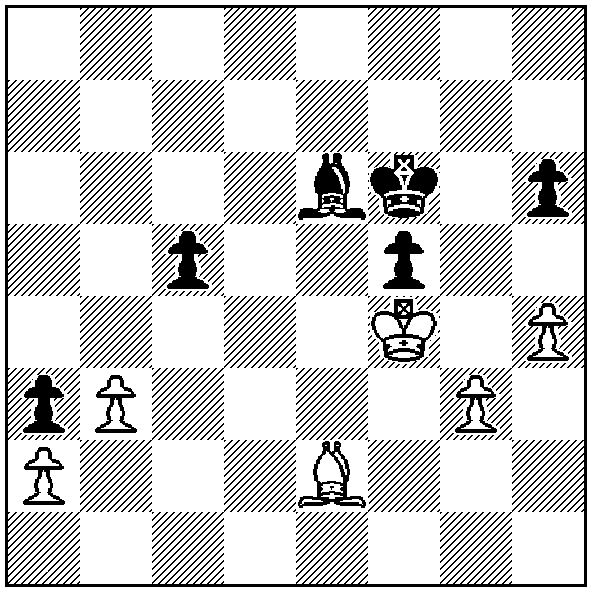
47.
Ke3
To
this sort of blunder he became liable the moment the adverse pawn
reached a3. The only correct move was Bc4.
47.
... Bxb3 48. Kd2 Bxa2 49. Kc3 Ke5 50. Bd3 f4 51. g4 f3 52. g5 hxg5 53.
hxg5 f2 54. g6 Kf6 55. Kc2 Bd5,
and
White resigned.
Source:
The
Chess Player's Chronicle,
April 5, 1881 (notes by James Mason*).
Frank
Healey
- W.A.
Lindsay
1.
e4 e5 2. Nf3 Nc6 3. Bb5 a6 4. Ba4 Bc5
The
more usual, and we fancy better, move at this point is Nf6. The form of
defense adopted by Black is not favorable to him; it being found in
practice that the advance of the queen's wing's pawns so soon in the
game, and with the sole object of driving off the adverse bishop, cannot
be safely made.
5.
0–0 b5 6. Bb3 Nf6 7. d3 d6 8. h3 Qe7 9. Nc3 Be6 10. Ne2 h6 11. c3 Bb6
12. Ng3 Qd7 13. Kh2
Lest
Black might be tempted to sacrifice his queen's bishop for two pawns.
But such a sacrifice would scarcely be ventured upon, we believe, and
certainly would be anything but sound. Perhaps he should have played
Bc2.
13.
... Ne7 14. Bc2 g5
This
looks as though Mr. Lindsay had made up his mind to altogether waive his
privilege of castling, depending for success upon an immediate and
direct assault with such of his forces as are already in action. If so,
we think he erred in not following up his design more consistently, by
going on with the pawn at move 17 instead of playing Bc7.
15.
d4 exd4 16. cxd4 c6 17. Be3
Threatening
d5, which would apparently result in the gain of a piece.
17.
... Bc7 18. d5
White
seems to have the advantage here, and soon wins the exchange; but the
resources of Black's position are much greater than might be supposed.
He gets a couple of pawns ahead, and is capable of damaging his
adversary in the counter-attack ensuing.
18.
... cxd5 19. Bd4 dxe4 20. Bxf6 exf3 21. Be4 fxg2 22. Bxg2 0–0–0 23.
Bxh8 Rxh8 24. Qd4 Rg8 25. Qa7 Kd8 26. Rac1 d5 27. Qxa6 h5 28. Kg1 h4 29.
Ne2 Bxh3 30. Qa8+ Qc8
Were
it not for thus being obliged to interpose his queen, Black would now
have much the best of the struggle. But with the queens off the field,
the power of the exchange governs.
31.
Qxc8+ Bxc8 32. Nd4 h3 33. Bf3 g4 34. Be2 g3 35. fxg3
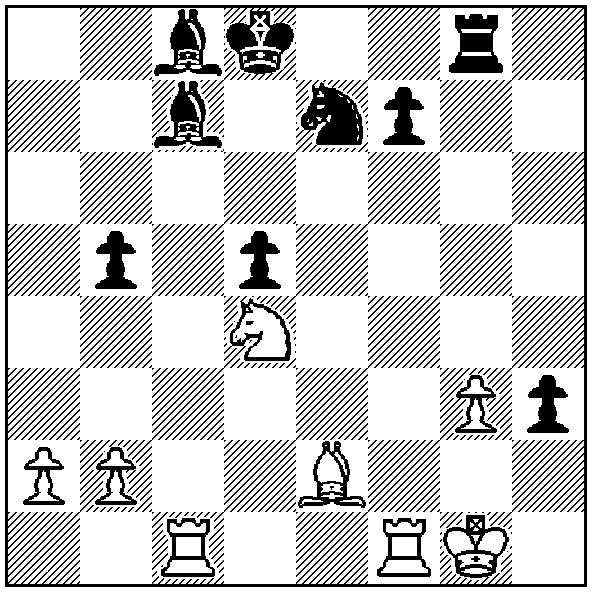
35.
... Bxg3
Bb6
would have been better. 35. ... Bb6 36. Rf4 Nf5 37. Rxc8+ Kxc8 38. Rxf5
Bxd4+, and easily draws.
36.
Kh1 h2 37. Rxf7 Be5 38. Nf3 Bxb2 39. Rc2 Ba3 40. Bxb5 Nf5
A
mistake, which loses a piece and the game.
41.
Rxc8+ Kxc8 42. Rxf5 Bc5 43. Kxh2,
and
wins.
Sources:
The
Chess Player's Chronicle,
April 19, 1881 (notes by James Mason); The
British Chess Magazine, June 1881, pages 204-206.
The
British Chess Magazine
offered only 41 moves.
George
C. Heywood
- W.F.
Ball
1.
e4 e5 2. Nf3 Nc6 3. Nc3 Nf6 4. Bb5 Bb4 5. 0–0
Nd5
is the usual move here.
5.
... 0–0 6. d3 d6 7. Bxc6
An
inferior continuation; Bg5 or Ne2 was the proper course.
7.
... bxc6 8. Ne2 h6
This
should be a source of weakness to the king's quarters. Re8 with a view
to playing pawn to d5 was better.
9.
Be3 Ba5 10. Ng3 Bb6 11. Qd2
We
prefer d4, to avoid the exchange of bishops.
11.
... Ng4 12. Rad1
As
he cannot now preserve his bishop, he should take bishop with bishop at
once, and then drive back the knight.
12.
... f5
Our
inclination would certainly have been to capture the bishop with knight,
retaining two bishops against two knights.
13.
exf5 Bxf5 14. Bxb6 axb6 15. Qc3
Before
making this move he should have taken the bishop.
15.
... Be6 16. Qxc6 Rxa2 17. h3 Nf6 18. Ne4 Nd5
The
stroke and counterstroke here are well conceived. White's last move was
intended to enable him to take the king's pawn with his knight in case
of rook taking pawn. Black now prevents this by threatening Ne7.
19.
Nc3
An
injudicious move. White had no way, we believe, of saving the loss of a
pawn except by Rb1, in which case Black would have got a good attack by
Nf4.
19.
... Ne7 20. Qe4 Ra8 21. d4 Bf5 22. Qe2 exd4 23. Nxd4 Qd7 24. Rfe1 Rf7
25. Qc4
If
25. Qf3 Raf8 26. Nd5, Black dare not then play 26. ... Bxc2, on account
of 27. Nxe7+ Kh7 (if queen or rook takes knight then Qd5) 28. Qc3 Bxd1
29. Qd3+ Kh8 30. Ng6+, winning a piece. Black, however, could reply to
26. Nd5 by Ng6.
25.
... d5 26. Qb5 Ra5
This
loses a pawn. Qd6 or Rd8 was best.
27.
Qxd7 Bxd7 28. Nb3 Ra8 29. Nxd5 Nxd5 30. Rxd5 Ra2 31. Red1
Rb1
was the correct play if he wanted to win, for Black should have answered
the present move by Ba4.
31.
... Bf5 32. Nd4 Bh7
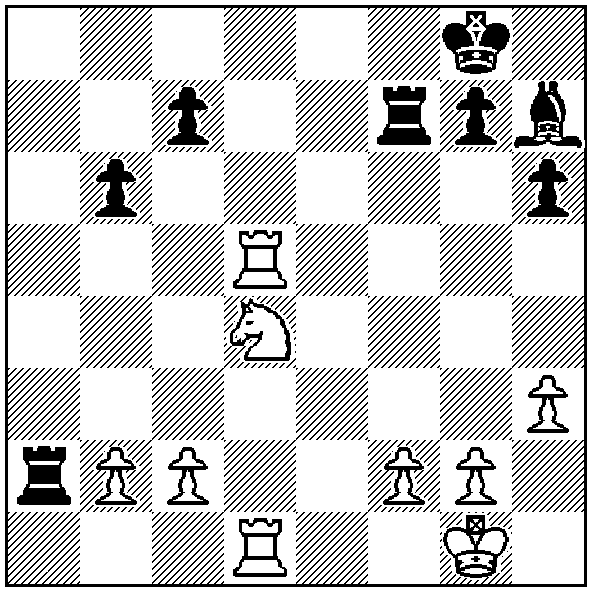
33.
Rb5
This
should incur the loss of the pawn he had won, whereas Rd8+, Rxf8+, and
Ne6+ he could still preserve it.
33.
... Rd7 34. Rd2 Bxc2
In
too great a hurry. The right move was Ra8, for if White then played c3,
Rad8 would win the exchange or a piece.
35.
Rxc2 Rxd4 36. Rxc7 Rd2 37. Rxb6 Raxb2 38. Rxb2 Rxb2 39. g4 Kh7 40. Kg2
Rb5 41. h4 Rb4 42. Kg3 Ra4 43. h5 Rb4 44. Re7 Ra4 45. f3 Rb4 46. Re4 Rb6
47. Kh4 Rf6 48. f4 Ra6 49. g5 hxg5+ 50. Kxg5
An
error which spoils his chance of winning; he should have retaken with
the pawn.
50.
... Kg8 51. f5 Kf7 52. Re6
Well
played, but Black is not to be caught in the trap.
52.
... Ra1 53. Re4 Rg1+ 54. Rg4 Ra1 55. h6 gxh6+ 56. Kxh6 Kf6,
and
the game is drawn.
Source:
The
British Chess Magazine,
June 1881, pages 203-204 (notes by Charles E. Ranken).
Charles
Puller
- Theodore
Block
1.
e4 e5 2. Nf3 Nc6 3. Bc4 Be7
The
effect of this should be to give the second player a rather cramped
position, something similar to those usually arising from Philidor's
Defense. White's best answer seems to be d4, not c3, as played by Mr.
Puller.
4.
c3 Nf6 5. Qe2 d6 6. 0–0 0–0 7. d4
Here,
we think, White should have prevented the pinning of his knight.
7.
... Bg4 8. d5 Nb8 9. Bd3 c6 10. c4 Nbd7 11. Nc3
Nc5 12. Bc2 h6 13. b4
There
is nothing gained by dislodging the knight just now; and the advance of
the pawns weakens the position of the queen's side of the board
materially. Pawn to h3 was better.
13.
... Na6 14. a3 Nc7 15. h3 Bh5 16. g4
Extremely
hazardous play. We should have preferred Nd1, to be followed presently
by Ne3, and then to f5, should circumstances seem favorable.
16.
... Bg6 17. Nh2 Nd7
Anticipating
White's design of advancing his bishop's pawn. Though White has some
attack it is hardly a compensation for the certain dangers attending its
failure, if it should fail, and Black's situation seems to us a
perfectly safe one.
18.
f4 exf4 19. Bxf4 Bf6 20. Bd2 Qe7 21. Rae1 Rae8 22. Qf3 Bd4+ 23. Kg2 Nf6
Black
must win the king's pawn now.
24.
Ne2
An
error, perhaps. He might have moved Rook to e2 with the object of
doubling should Black venture to go in for the pawn at once - or rather
after first playing Bxc3.
24.
... Bxe4 25. Bxe4 Qxe4
There
was nothing in queen takes queen followed by Kf3 in case Black retook
with rook.
26.
Nxd4 Qxd4 27. Bc3 Qxc4 28. Bxf6 gxf6 29. Qxf6 Qxd5+ 30. Nf3
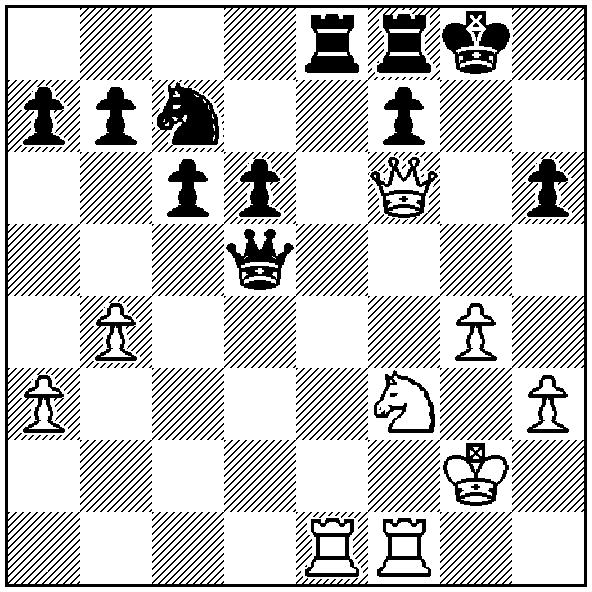
30.
... Re6
Excellent
play. Mr. Block has the game in his hands now, the superior force
winning without much difficulty.
31.
Qb2 Rfe8 32. Qf2 Rxe1 33. Rxe1 Rxe1 34. Qxe1 Ne6 35. Qe3 Ng5
White
should have prevented this either by moving his king or pushing the
rook's pawn.
36.
h4 Qxf3+ 37. Qxf3 Nxf3 38. Kxf3 Kg7,
and
wins.
Source:
The
Chess Player's Chronicle,
April 19, 1881 (notes by James Mason).
Charles
Marrett
- W.
Elliot Vyse
1.
e4 e5 2. Nf3 Nc6 3. c3 d5 4. Qa4 f6
Invented
by Steinitz, and doubtless Black's best.
5.
Bb5 Nge7 6. exd5 Qxd5 7. 0–0 Bd7 8. c4
Not
so good as Bc4. We are, however, inclined to think that pawn to d4 is
better than either. Pawn to d4 would also be good against Black's eighth
move.
8.
... Qf7 9. Qc2 Ng6 10. d3 a6 11. Ba4 Bc5 12. Nc3 Rd8 13. a3 Nd4 14. Nxd4
Bxd4 15. Nd5 0–0 16. Bb3 c5 17. Kh1 Ne7 18. Nc3 Bf5 19. Ne4 Qg6 20.
Be3 Bd7 21. Bxd4 cxd4 22. Qe2
The
play on both sides during the last fourteen moves has been a fair fight,
therefore criticism, though possible, is not called for. White has
obtained some superiority, which he might here improve
by 22. c5+, followed by 23. Nd6; a course, no doubt discussed as
being hazardous, but the balance of danger would be against Black.
22.
... Bc6 23. Rae1 f5 24. Ng3 f4 25. Ne4 Rf5
We
favor Nf4. The text move is dangerous without being promising.
26.
Bd1 Rdf8 27. Qf3 Kh8
Purposeless.
Hampered by the placement of his rooks, there is little for him to do;
but Qh6 would, at least, imply an attempt to do something.
28.
b4 b5 29. Qg4 Qh6 30. Rg1 Bxe4 31. Rxe4 R8f6 32. h3
Rge1
is stronger.
32.
... Rg6 33. Qf3 Rfg5 34. cxb5 axb5 35. Kh2 Ra6 36. Rge1 Qd6 37. Qe2 Ng6
38. Qb2 h6 39. Bg4 Rc6 40. Rc1 Kg8 41. Ree1 Nh4
Skillfully
devised, and highly hopeful.
42.
g3
If
Qe2, then Qd5.
42.
... Rxg4 43. gxh4
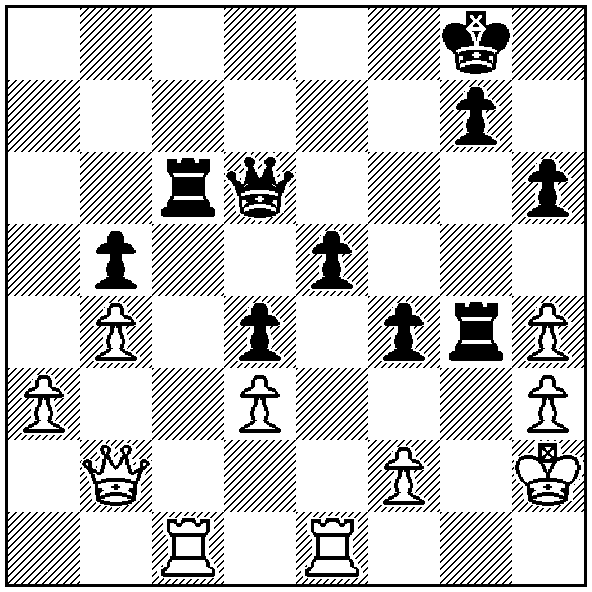
43.
... Rxc1
Badly
played; in fact, an all-round blunder of the most perfect kind, for it
sacrifices possibilities, both offensive and defensive; brings in
dangers that did not exist before. and presents the adversary with a
clear move in advance. The right course is 43. ... Rxh4, followed, if
44. Rxc6, by Qxc6, and White cannot take the king's pawn on account of
Qf3.
44.
Qxc1 Rxh4 45. Qc8+ Kh7 46. Qf5+ Qg6 47. Qxg6+
Exceedingly
weak. Rxe5 wins easily.
47.
... Kxg6 48. Rxe5 Rh5 49. Re4 Rd5 50. Rxf4 Kg5 51. Rg4+ Kf6 52. Kg3 g5
53. h4 h5 54. Re4 g4 55. f3 gxf3 56. Kxf3 Rf5+ 57. Kg3 Rd5 58. Re8 Re5
59. Rf8+ Kg6
Altogether
ill-judged. Ke6 is not only his only resource, but a very good one.
60.
Rf3 Rf5 61. Rf4 Re5
Neither
by going back to d5, nor by any other course can he save the game; and
therefore, the text move, though it shortens the struggle, need not be
censured.
62.
Rxd4 Re3+ 63. Kf4,
and
wins.
Source:
Land
and Water,
June 11, 1881 (notes by William N. Potter).
Samuel
Stevens
- Walter
M. Gattie
In
reference to the position of the first game between Messrs. Gattie and
Stevens, noticed in our last week's report, the former gentleman wishes
us to state that he did not overlook the line of play we pointed out,
and that he held a counter manoeuver in reserve, which we acknowledge as
ingenious in maintaining the best of the position for Mr. Gattie. We
modify our criticism to that extent, that the variation we suggested
would have been still the best course for Mr. Stevens to adopt for the
purpose of prolonging the defense, while his opponent was clearly
prepared with a good answer. The position was as follows:
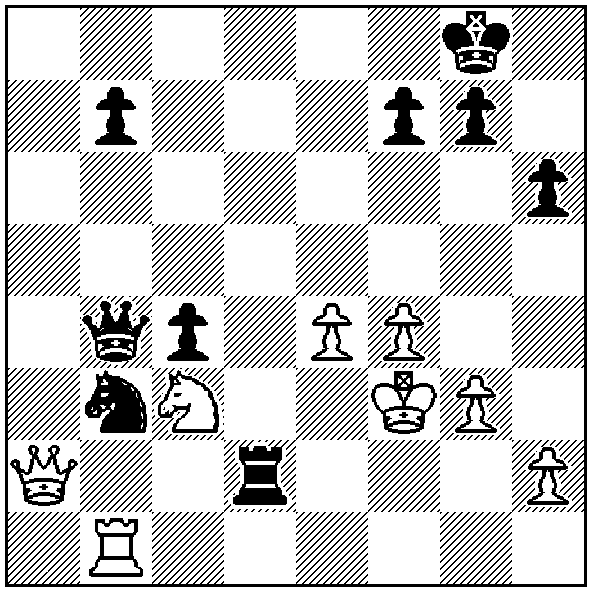
White
to play, gave the check at a8 at once, followed by Nd5; and Gattie,
after moving the king, won by Nd4+. We proposed instead Rxb3, and Mr.
Gattie points out the strong reply, Rd3+, followed by Qc5; but, though
he must have won by this move, if rightly followed up, we believe that
it would not have been as obvious as it may appear at first sight, for
the game might have proceeded thus: Rxb3 Rd3+ Ke2 Qc5 Rxb7 Qe3+ Kf1; and
should Black now be tempted to attack the queen with rook at d2, White
would have some prospect of drawing by Qxd2, followed by Ne2 and Rc7;
but Rxc3 instead would, however, leave Black with a winning position.
Source:
The
Field,
April 2, 1881 (notes by Wilhelm Steinitz).
Back
to the main picture of this article. The title of the drawing was 'Tournament
by the City of London Chess Club.' The artist was Horace Morchen, an
illustrator who was frequently working for The Illustrated Sporting
and Dramatic News. The engraving was also signed by John
Swain. He was an
independent London wood engraver, also working for Punch and The
Engineer.
----------
*
The diagram was given in the original source.
----------
Notes:
1 Land and Water, November 26, 1881; The Illustrated Sporting and Dramatic News, November 26, 1881;
The Chess Player's Chronicle, November 29, 1881; The Field,
December 3, 1881. 2 The Illustrated Sporting and Dramatic News, November 26, 1881; The
Chess Player's Chronicle, November 29, 1881. 3 The Illustrated Sporting and Dramatic News, November 26, 1881; The
Chess Player's Chronicle, November 29, 1881; The
Field, December 3, 1881. 4 The Chess Player's Chronicle, November 29, 1881; Land
and Water, December 10, 1881. 5 The Chess Player's Chronicle, November 29, 1881. 6 Glasgow Weekly Herald, December 17, 1881. 7 The Illustrated Sporting and Dramatic News, November 26, 1881.
8 Glasgow Weekly Herald, December 17 and 24, 1881. 9 The Illustrated Sporting and Dramatic News, December 24, 1881.
10 The
British Chess Magazine,
April 1881, page 117; The Chess
Monthly, March 1881, page 193. According to The Field (March 5, 1881), the challenge was for a match between the
third class of each side. 11 Land
and Water, February 26, 1881; The
Chess Player's Chronicle, March 1, 1881. 12 The
Chess Player's Chronicle (March 1, 1881) thought this was a match
between the two strongest chess clubs in the world; The London Figaro (March 9, 1881) called it one of the greatest chess
events which had ever taken place in the metropolis. Leopold Hoffer in The
Chess Monthly, (March 1881, page 193) wrote: "Should the two clubs
come to an understanding, of which we have no doubt, as both are anxious
to play, we will witness the most interesting battle of many a season."
Wilhelm Steinitz in The Field
(March 26, 1881): "On Thursday last, the most memorable chess contest
over the board was consummated, which has ever been recorded between the
representatives of two societies who make the cultivation of our game
their sole object. We do not think that any single club in the world
could produce a team comprising so many highly reputed players as were
marshalled on each side..." George A. MacDonnell in The
Illustrated Sporting and Dramatic News (April 2, 1881): "Never have I seen a more numerous or distinguished assemblage
of chess-players than met together at Willis's Rooms, St. James's,
on Thursday, the 24th March, to witness or take part in the great match
between the City and the St. George's Clubs. Again Wilhelm Steinitz,
this time in the London Figaro
(March 30, 1881): "This great contest, which took place on the 24th
inst., as previously announced, will leave the mark on the records of
the most important chess events." The
British Chess Magazine (April 1881, page 117):
"Never before, we believe, in the annals of Chess has such a
memorable contest occurred as that which took place at Willis's Rooms,
King Street, St. James' Square, London, on the evening of March 24th.
There have been, no doubt, in various International Chess Congresses
larger gatherings of first-rate masters of the game; there have also
been greater numbers on each side in many a one-day match between divers
contending clubs; but never, we think, has such a combination of force
and numbers been seen before in any club battle, and certainly there has
been no similar trial of strength which has awakened more wide-spread
interest." 13 The
Chess Player's Chronicle, March 1, 1881; Glasgow Weekly Herald, March 5, 1881; The Field, March 5, 1881. 14 Land
and Water, March 5, 1881; The
Illustrated Sporting and Dramatic News, March 12, 1881; Glasgow Weekly Herald, March 19, 1881. 15 The
British Chess Magazine, December 1881, page 388. 16 Chess
Player's Annual and Club Directory, 1882, page 76. 17 The
Illustrated Sporting and Dramatic News, March 5, 1881. 18 Glasgow
Weekly Herald, March 19, 1881. 19 The
Illustrated Sporting and Dramatic News, March 19, 1881. 20 The
Illustrated Sporting and Dramatic News, March 12 and 19, 1881; Glasgow
Weekly Herald, March 19, 1881; Land
and Water, March 19, 1881. 21 Land
and Water, March 12 and 19, 1881; The
Illustrated Sporting and Dramatic News, March 19, 1881. 22 Glasgow
Weekly Herald, March 19, 1881. 23 Glasgow
Weekly Herald, April 8, 1881. 24 The
Chess Player's Chronicle, March 29, 1881; London Figaro, March 30, 1881; The
Illustrated Sporting and Dramatic News, April 2, 1881; Glasgow Weekly Herald, April 8, 1881; The British Chess Magazine, April 1881, pages 117-119. 25 The
Illustrated Sporting and Dramatic News, April 2, 1881. 26 Glasgow
Weekly Herald, April 8, 1881. 27 The
Chess Player's Chronicle, March 29, 1881; The Illustrated Sporting and Dramatic News, April 2, 1881; The
British Chess Magazine, April 1881, pages 117-119; The
Chess Monthly, April 1881, pages 225-226. 28 The
Illustrated Sporting and Dramatic News, March 12, 1881. 29 The
Illustrated Sporting and Dramatic News, April 2, 1881, and The
British Chess Magazine, April 1881, pages 117-119, gave a final
score of 12 to 10. The Chess Player's Chronicle, March 29, 1881, London Figaro, March 30, 1881, The
Illustrated London News, April 2, 1881, Glasgow
Weekly Herald, April 2, 1881,
The Chess Monthly, April 1881, pages 225-226,
offered, like Land and Water,
12 to 9. 30 Land
and Water, April 2, 1881. 31 The
Illustrated Sporting and Dramatic News, April 2, 1881. Ballard and
Hirschfeld joined the City club again later in 1881. 32 Land
and Water, March 12 and 19, 1881. 33 The
Illustrated Sporting and Dramatic News, April 2, 1881.
----------
Pictures:
Tournament by the City of
London Chess Club (The Illustrated Sporting and
Dramatic News, December 24, 1881); Johannes H. Zukertort (Columbia
Chess Chronicle, July 14, 1888); Wilhelm Steinitz (Neue
Illustrirte Zeitung, September 7, 1873); Charles E. Ranken (The
Chess Monthly, May 1891); Frederic H. Lewis (The Chess Monthly,
July 1889); William Wayte (The Chess Monthly, November 1889);
John Owen (The Chess Monthly, May 1894); James I. Minchin (The
Chess Monthly, February 1890); Walter M. Gattie (The Chess
Monthly, August 1890); George C. Heywood (The British Chess
Magazine, December 1893); Frederick W. Lord (The Chess Monthly,
May 1895); Samuel S. Boden (The Westminster Papers, September
1876).
©
December 2014 Joost van Winsen. All Rights Reserved
|
